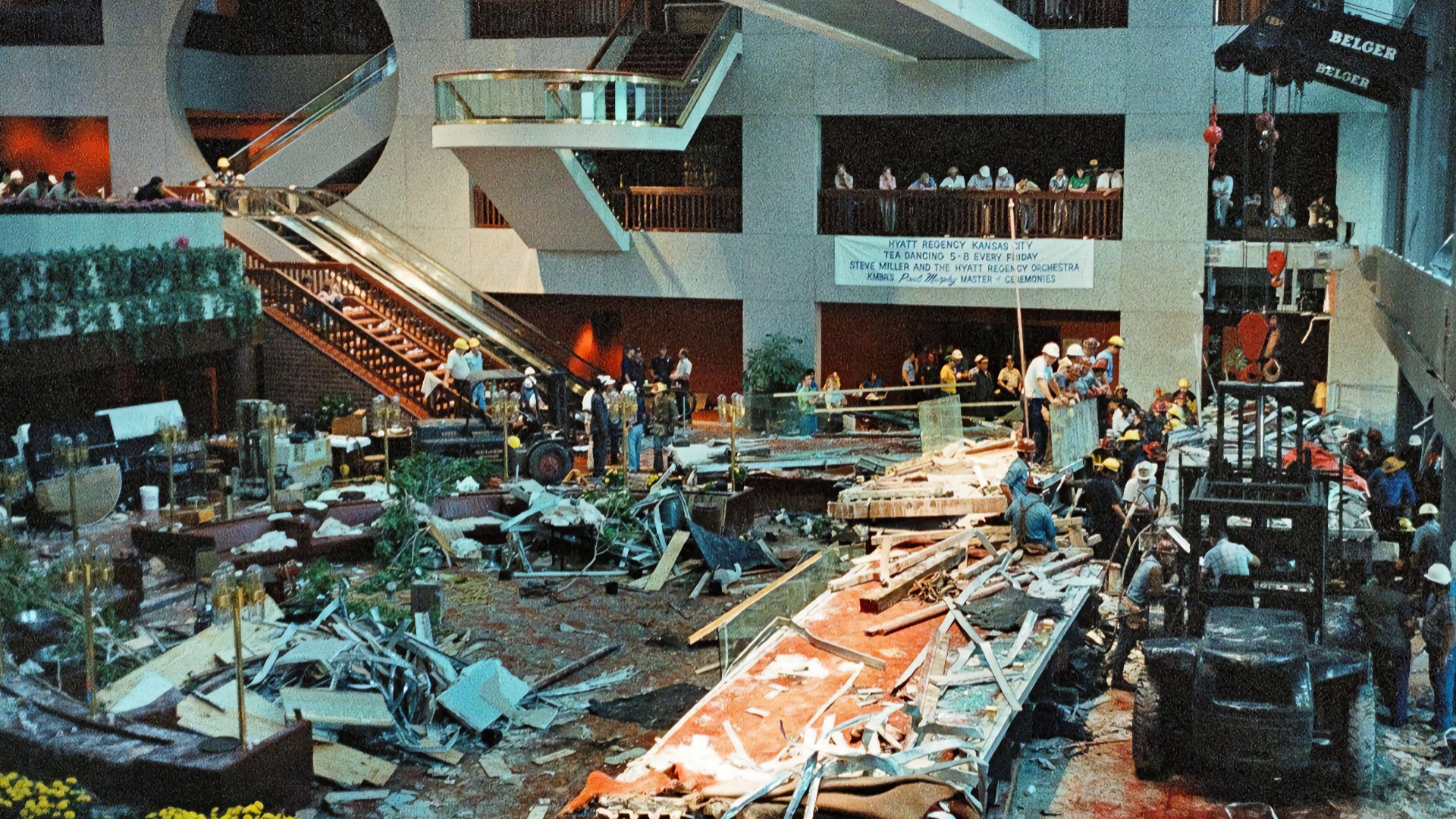The Hyatt Regency Walkway Collapse
On the evening of 17 July 1981, a tragic structural failure at the Hyatt Regency Hotel in Kansas City, Missouri, led to one of the deadliest engineering disasters in United States history. A bustling event turned into chaos when two elevated walkways inside the hotel collapsed, killing 114 people and injuring more than 200 others. The incident not only exposed severe flaws in design and construction but also led to significant changes in engineering ethics, building codes, and safety regulations.
The Hyatt Regency Hotel was a newly constructed luxury venue, having opened its doors in 1980. A key architectural feature of the hotel was its multi-storey atrium, which included a series of suspended walkways designed to provide easy access between floors while offering an aesthetically impressive open space. On the evening of the collapse, the hotel was hosting a popular tea dance event, attracting hundreds of guests. The walkways, suspended above the lobby, became a vantage point for spectators eager to watch the festivities below. However, the very structure that provided convenience and beauty concealed a fatal flaw.
The disaster unfolded in mere seconds. At 7:05 p.m., as music played and guests enjoyed the evening, the fourth-floor walkway, which was directly above the second-floor walkway, suddenly gave way. The immense weight of the upper bridge crashed down onto the lower one, and both structures plummeted onto the crowded dance floor below. Survivors recalled a deafening noise, followed by a cloud of dust and screams as people were trapped beneath tonnes of debris.
Rescue efforts commenced immediately, but the scene was one of devastation. First responders, along with volunteers, worked through the night to pull victims from the wreckage. Many were severely injured, crushed under fallen steel and concrete. Some victims remained trapped for hours, pinned by debris while emergency personnel struggled to reach them. The response was complicated by the weight and instability of the fallen structures, making every move a delicate balance between saving lives and preventing further collapse.
Investigations into the disaster revealed a catastrophic design flaw that ultimately led to the failure of the walkways. Originally, the walkways were intended to be suspended by a continuous set of steel rods running from the ceiling through both levels of the walkways. However, during construction, a critical modification was made that changed the load distribution. Instead of a single set of rods supporting both walkways, the design was altered so that the fourth-floor walkway was suspended from the ceiling, while the second-floor walkway was hung beneath it. This seemingly minor change had disastrous consequences, effectively doubling the load on the upper walkway’s connection points. When the structure failed, the weight of both walkways came crashing down, exceeding what the design could withstand.
The Hyatt Regency Walkway Collapse was a pivotal moment in the field of engineering ethics and accountability. The investigation found that the engineers responsible for the project had not performed adequate stress analysis on the modified design. The connection points, which bore the brunt of the load, were insufficiently reinforced, making failure inevitable under the weight of a crowded walkway. The engineering firm responsible, Gillum-Colaco, faced severe repercussions. The engineers in charge of the design lost their professional licences, and the disaster led to stricter enforcement of design review and approval processes.
Beyond the technical failures, the collapse raised broader questions about communication, responsibility, and oversight within the construction industry. The lack of rigorous checks and balances allowed a flawed design to be implemented without recognising the risk it posed. As a result, building codes and regulations were revised across the country to ensure that similar oversights would not occur in future projects. The disaster underscored the need for rigorous peer review, independent structural analysis, and strict adherence to safety protocols in all construction projects.
The legal consequences of the collapse were significant. Lawsuits were filed against the hotel’s owners, construction firms, and engineering teams. A major settlement was reached, with compensation awarded to victims and their families. However, no criminal charges were brought against the individuals responsible for the design flaw, a decision that sparked debate over accountability in engineering failures. The case reinforced the importance of professional responsibility and served as a stark warning to the industry about the dangers of cutting corners or making unverified alterations to critical structural components.
In the years following the disaster, the site of the Hyatt Regency Walkway Collapse was transformed into a memorial to honour those who lost their lives. The event remains a case study in engineering courses worldwide, serving as an example of the consequences of inadequate design review and professional negligence. Engineers today study the failure to understand the importance of accountability, ethical responsibility, and rigorous safety standards in their work.
The lessons learned from the Hyatt Regency disaster have had a lasting impact on engineering practices. Structural integrity is now scrutinised more rigorously, and safety has become a paramount concern in design and construction. The tragedy highlighted the critical role engineers play in ensuring public safety and the potential consequences of failing to uphold those responsibilities. It also demonstrated the necessity for improved communication between architects, engineers, and builders to prevent similar disasters. Although decades have passed since the Hyatt Regency Walkway Collapse, its legacy endures as a cautionary tale. The changes in engineering standards, increased awareness of structural safety, and ongoing education in ethical engineering all stem from the hard lessons learned on that fateful night in Kansas City. The tragedy serves as a reminder that in the built environment, even small design decisions can have life-or-death consequences. For those who lost their lives, the ultimate tribute is ensuring that such a failure never happens again.
The Hyatt Regency Walkway Collapse FAQ
On 17 July 1981, two suspended walkways inside the Hyatt Regency hotel in Kansas City, Missouri, collapsed during a dance event, killing 114 people.
A critical design flaw in the steel rod supports, combined with construction changes that were not properly reviewed, led to the catastrophic structural failure.
The collapse killed 114 people and injured over 200 others, making it one of the deadliest structural failures in U.S. history.
The tragedy led to major changes in engineering standards, stricter building inspections, and a renewed focus on accountability within the construction industry.
[this article originally appeared on 5MinuteDisasters.com on 14 June 2025]






